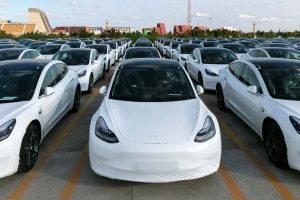- 🚧 Tesla has received approval to begin the first stage of expanding Gigafactory Berlin, which aims to double the plant’s production capacity.
- 🌱 The expansion includes new logistics facilities, a battery cell test and recycling lab, and additional infrastructure within land already owned by Tesla.
- 🌍 Tesla’s plan faces opposition from environmental activists and local citizens, particularly concerns about tree-clearing efforts.
- 💣 An undetonated World War II bomb was found near the factory, prompting a larger search of the area for other old ammunition.
- 📈 The expansion is contingent upon market demand, potentially boosting production from 500,000 vehicles to one million per year.
Tesla’s Gigafactory Berlin, a notable landmark of innovation and technological progress, is set to expand as approval has been granted for the first phase of its enlargement plans. This ambitious project aims to double the plant’s production capacity, positioning it to become the most productive automobile factory in Germany, surpassing even Volkswagen’s Wolfsburg facility. However, the path to expansion is fraught with challenges, ranging from environmental concerns to the intricacies of fluctuating market demand. In this blog post, we will delve into Tesla’s expansion strategy, the opposition it faces, and the potential market implications.
The Scope of Giga Berlin’s Expansion
Tesla’s expansion at Gigafactory Berlin focuses on increasing its manufacturing capabilities significantly. The key elements of this expansion include:
- Logistics Facilities: New logistics units are to be constructed to streamline operations and enhance the overall efficiency of vehicle production.
- Battery Cell Test and Recycling Lab: Establishing specialized labs will allow Tesla to innovate and optimize battery performance, a critical component of electric vehicles.
- Additional Infrastructure: Expanding current facilities for storage and other necessary operations, this will occupy land already owned by Tesla.
The completion of these developments is pivotal to achieving the targeted doubling of production capacity, increasing current output from 500,000 to 1,000,000 vehicles annually.
Environmental Concerns and Opposition
With technological advancements come inevitable environmental considerations. Tesla’s expansion in Berlin has not been without its critics:
- Tree-Clearing Controversy: Significant backlash from environmental activists and local communities arose due to the tree-clearing activities undertaken to make room for construction. Such actions have sparked protests, challenging Tesla’s commitment to sustainability.
- World War II Ammunition Risks: The discovery of an undetonated World War II bomb in the vicinity of the factory underscores historical and safety concerns, necessitating further examinations of the land for similar hazards.
Local citizens have also expressed their views through a non-binding vote, opposing the environmental impacts of tree-clearing, highlighting a significant area of contention for Tesla as it navigates the expansion process.
Market Demand: The Driving Force
This ambitious growth strategy aligns with Tesla’s vision of retaining its competitive edge amidst evolving market conditions. However, the feasibility of such expansion is inherently linked to market demand. As Plant Manager André Thierig notes, the substantial investment required for this expansion is heavily dependent on clear market signals indicating a need for increased production capacity. Key considerations include:
- Demand for Electric Vehicles: As global trends shift towards sustainable and eco-friendly transportation solutions, Tesla anticipates a resurgence in demand, which would justify expansion efforts.
- Market Volatility: Fluctuations in economic conditions and consumer preferences could impact the pace and scope of expansion. Industry experts suggest closely monitoring these variables to ensure sustained growth.
Conclusion
Tesla’s Gigafactory Berlin expansion is a testament to the company’s commitment to scaling its operations and reinforcing its position as a leading force in the electric vehicle segment. While the path forward is not without its challenges, particularly concerning environmental impacts and market uncertainties, the potential benefits of increased production capacity are undeniable. As Tesla navigates these complexities, the industry and environmentalists alike will keenly observe how this expansion unfolds, setting a precedent for future endeavors in the automotive sector.





